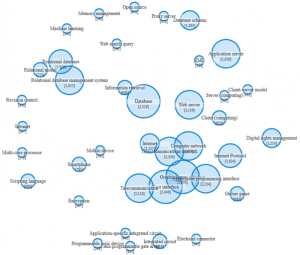
Salesforce.com, the first company to introduce round the clock software delivery over the cloud, is a leading provider of cloud-based enterprise software-as-a-service (SaaS). Founded in 1999, the San Francisco based company became an industry pioneer by bringing cloud, social and mobile to Customer Relationship Management (CRM). Salesforce is also the name of their flagship product which is a highly customizable CRM software with a multi-tenant environment.
With its cutting-edge technology solutions and products, Salesforce has won many accolades and built a strong patent portfolio. Salesforce was recognized as the “Innovator of the Decade” by Forbes in 2016. Along with its suite of innovative products, a series of acquisitions have added to the company’s technology portfolio and patent assets. Salesforce recently announced that it will be acquiring Tableau Software, the popular data visualization and analytics company for $15.7 billion in an all-stock deal, its biggest acquisition to date.
We provided an analysis of the technology trends and patent assets for Salesforce a few months back. This week we update our analysis of Salesforce’s patent portfolio and provide a glimpse into the patent assets held by Tableau.
Innovation through Acquisitions
Acquisitions have played a vital role in Salesforce’s growth strategy. The company has acquired close to 50 companies, with 2016 being the year with the maximum number of acquisitions.
Salesforce acquired around 12 companies in 2016 that fuelled its Artificial Intelligence (AI) platform, Einstein. Its acquisition of Demandware led to the development of Einstein’s commerce cloud, powering its predictive email and product recommendation features.
In the same year, Salesforce acquired Krux, a company that enables marketers, publishers and agencies to deliver smarter content and marketing experiences. Krux was incorporated into the Marketing Cloud and now forms Salesforce Data Management Platform (DMP). Another major acquisition of 2016 was Quip, a content collaboration platform that was embedded directly into Salesforce’s sales and customer service clouds. Quip is included as a tab in the Sales or Service Cloud interface where employees can collaborate on documents and manage information using a single platform.
Another significant acquisitions in 2016 was BeyondCore, a data analytics start-up with expertise in AI (artificial intelligence) and deep learning. BeyondCore’s technology provided the Einstein Analytics Cloud with Automated Analytics & Storytelling, Smart Data Discovery and Smart Data Prep features. Salesforce CEO Marc Benioff said that due to the tremendous shift in the software space, the demand for smarter and predictive analytics software is on the rise. The company invested in acquiring other machine learning and predictive analytics players such as Prediction IO, Tempo IO, MinHash and RelateIQ.
Salesforce purchased MuleSoft, an application and data integration company for $6.5 billion in 2018. Mulesoft provided integration software for connecting applications, data and devices. The company’s integration platform, Anypoint, enabled users to link their business applications, corporate IT infrastructure and databases into a unified system. Salesforce turned Anypoint platform into its Integration Cloud.
In 2018, another key acquisition by Salesforce was of the B2B e-commerce platform company, CloudCraze. The platform enabled businesses to deploy B2B or B2C storefronts and offered a configurable user interface with pricing, promotion and content management functionality, along with inventory, shipping and tax solutions integration. These attributes were added to Commerce Cloud, Salesforce’s cloud-based e-commerce platform that was built from the Demandware acquisition in 2016.
Salesforce acquired Attic Labs, creator of the first open-sourced decentralized database Noms, in 2018. Analysts commented that the acquisition was to provide Quip with enhanced back-end capabilities, enabling the tool to accumulate more data.
Earlier this year, Salesforce acquired MayAnything, a company that provided a suite of location intelligence apps and platform services to drive productivity and planning across multiple business needs. On the company blog, Salesforce commented, “The addition of MapAnything to Salesforce will help the world’s leading brands accurately plan: how many people they need, where to put them, how to make them as productive as possible, how to track what’s being done in real time and what they can learn to improve going forward.”
To top all of the above, Salesforce recently announced its acquisition of Tableau Software at an enterprise value of over US $15 billion. “Tableau helps people see and understand data, and Salesforce helps people engage and understand customers. It’s truly the best of both worlds for our customers – bringing together two critical platforms that every customer needs to understand their world,” said Marc Benioff, Salesforce’s chairman and co-CEO, in a statement.
This deal would enable Salesforce to include data visualization tools in its product portfolio with its core customer relationship management software.
Experts predict that this may make Salesforce a direct competitor to technology giants such as Microsoft and Google.
Technology Trends – Salesforce
Figure 1 shows a significant upward trend after 2012 in the overall number of published patents for Salesforce. The patenting activity peaks in 2018 with 615 publications.
Figure 2 is a Topic Map of the top technologies (based on key concepts) covered by Salesforce’s portfolio. In the figure, the size of a bubble corresponds to the total number of patent applications for a technology category. The bubble proximity corresponds to the similarity or “relatedness” of the individual technology categories.
The technologies related to database, telecommunications, user interface and application server are major contributors to the company’s technology portfolio.
Salesforce’s acquisitions, though not growing its patent portfolio significantly, have allowed it to incorporate powerful features into its platform and offer a greatly enhanced suite of products. It would be interesting to see what other acquisitions Salesforce has planned for 2019 and how these acquisitions change the competitive scenario in the SaaS space.











